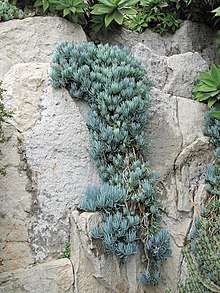Curio talinoides
Curio talinoides, syn. Senecio mandraliscae, also known as blue straws, blue chalksticks, dassieharpuis, or narrow-leaf chalk sticks, is a succulent plant of the sunflower family that is native to South Africa.[2] The origin of this plant is dubious and it may be a hybrid.[3]
| Curio talinoides | |
|---|---|
 | |
| Scientific classification | |
| Kingdom: | Plantae |
| Clade: | Tracheophytes |
| Clade: | Angiosperms |
| Clade: | Eudicots |
| Clade: | Asterids |
| Order: | Asterales |
| Family: | Asteraceae |
| Genus: | Curio |
| Species: | C. talinoides |
| Binomial name | |
| Curio talinoides P.V.Heath[1] | |
Description

The bluest of the curio plants, it is about 50 to 70 cm tall with 4.5-9.5 cm long leaves that are thickly and alternately arranged, jammed on the stems, and are set about 0.3-0.5 cm aside. The leaves are linear, rising, sickle shaped and would be narrow at both ends.
Unlike the similar looking Curio repens, its leaves are much narrower and elongated.[4] Curio repens is also easily distinguished by its shorter, often boat-shaped leaves.[5] It is also easily confused with Curio ficoides, which has a similar growth habit. However, the leaves of C. talinoides are rounded-cylindrical in cross section. In contrast, the leaves of C. ficoides are usually somewhat knife-like, flattened laterally.[6]
A hybrid of this and 'repens', known as Senecio 'Trident Blue' exists.
Subspecies and cultivars
- Senecio talinoides (DC.) Sch.Bip.: (subsp. talinoides) has finer texture
- Senecio talinoides subs. aizoides (DC.) G.D.Rowley: has 2-8 capitula per inflorescence
- Senecio talinoides subs. chordifolius (Hook.f.) G.D.Rowley: has the longest leaves and is more droopy
- Senecio talinoides f. cristatus: has a crested form.
- Senecio talinoides subs. cylindricus (A.Berger) G.D.Rowley: has cylindrical leaves
- Senecio talinoides subs. mandraliscae (Tineo) G.D.Rowley: has short spindle-like leaves 5-8 mm as long, later elongating.
References
- Heath, P.V. 1999. Calyx 6(2): 55.
- Brummitt, R.K. 2001. TDGW – World Geographical Scheme for Recording Plant Distributions, 2nd Edition
- Curio talinoides var. mandraliscae (Tineo) P.V.Heath by Llifle, The Encyclopedia of Succulents
- Curio talinoides (DC.) P.V.Heath by PlantZAfrica.com
- Curio talinoides by World of Succulents
- G.Rowley (1994). Succulent Compositae: A Grower's Guide to the Succulent Species of Senecio & Othonna. Strawberry Press. ISBN 0912647124, 9780912647128